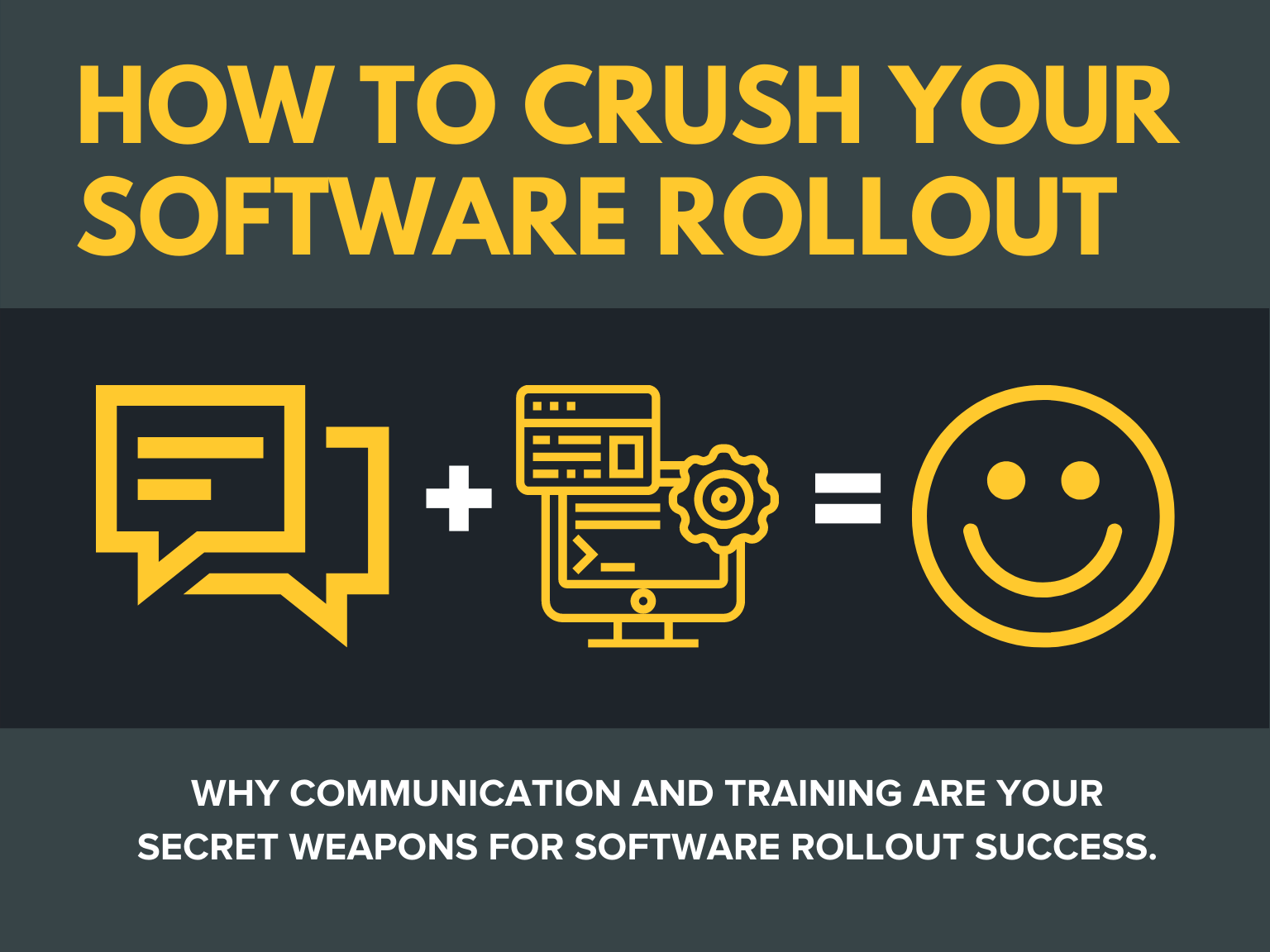Change is scary, and major software rollouts can be some of the most frightening changes your organization’s users experience.
It’s easy to forget that not everyone is a tech guru.
For some of your colleagues, mastering a new technology or software application can be daunting at best and — at worst — incredibly disrupting and frustrating.
In the end, successful implementation equals successful software adoption.
So, how do you manage user expectations and experiences while ensuring the tech side also goes smoothly?
I’ll show you.
A good plan that centers your users and focuses on communication and training can go a long way in making sure your org’s software rollout isn’t just good, but a smashing success.
Here’s what you’ll learn in our software rollout guide:
- The essential elements of your rollout plan.
- How to get buy-in across your organization.
- How to effectively communicate with your users.
- Why training is your top priority.
- Four mistakes that can sink your rollout before it begins.
Quickly and Easily Create Software Training Videos and Documentation
Camtasia and Snagit help you easily create everything from simple training guides to complete software training video courses — no pro skills required!
How to create a software rollout plan
It may seem like a no-brainer, but just like any project in your organization, you should create a plan on how to roll out new software. And that plan should address the lead-up to launch, the launch itself, and post-launch.
For this article, we’re going to assume you and your team have done due diligence in assessing your organization’s business goals and needs, including budget, software capabilities, security issues, etc.
Figuring these all out ahead of time will ensure team members spend less time and effort in the long run.
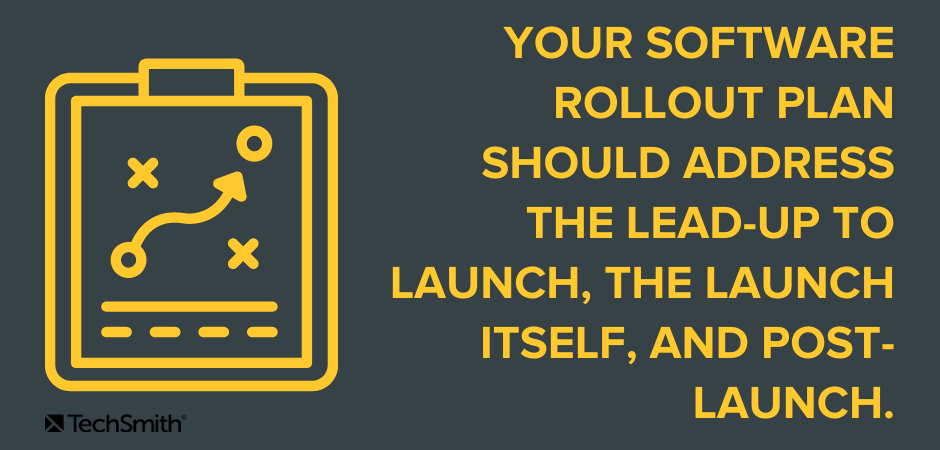
You’ve already chosen the software program or enterprise software you need, now you need to address how to get it to your users.
Follow software rollout best practices
Long before you even think about launching your new software, you need a new software rollout plan that covers: how you will roll it out, to whom, on what schedule, and — most importantly — how you will communicate with your users about the rollout and provide any training documents they may need.
While most IT teams understand the importance of planning the technical work of a software rollout, it’s easy to forget the human impact of your project.
You and your team will obviously do the work of rolling out the new software, but your planning must center your users’ needs, fears, expectations, and concerns about the upcoming launch.
In your planning, think carefully about the best practices for rolling out the new software by asking key questions:
- Will this be an all-org rollout or a phased approach?
- If phased, who gets it first and why?
- How will this impact our users?
- How will this impact our customers or other stakeholders?
- What can we do to help users understand what this means for them?
- Who will be the point person for communication on the rollout?
- How will we address fears, concerns, and complaints?
- How will we support our users through the transition and after the rollout?
- Who in our organization can help with the communication and training?
Plan for everyone
Even if your company is a software or technology provider, you can bet that not everyone on your team is as comfortable with technology as you are. It’s always best to assume that there will be users who know just what they need to do their jobs and nothing more.
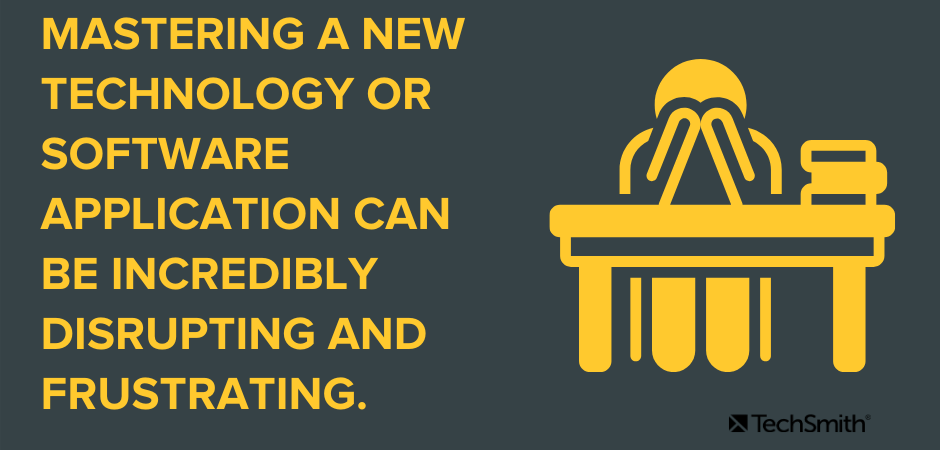
Once, when training Microsoft Word users on accessibility, I made a casual reference to using CTRL-C to copy and CTRL-V to paste. They stared at me as if I was speaking another language.
These were people who had been using Word and other MS Office applications for years, if not decades. Despite their longtime use of the product, almost none of them had heard about hotkeys or had ever used them.
That was an incredibly eye-opening experience for me in terms of training. Never assume that even experienced users know what you know.
You don’t want to treat them like novices, but remember there will be varying degrees of experience and knowledge.
Get buy-in for your software rollout across your entire organization
You’ve chosen your new software. You’ve made your case to your managers and other senior leadership in your organization. You’ve listed the pros and cons and made recommendations, and they’ve given you the green light.
You’re ready to roll, right?
Well, that depends. Who ELSE did you talk to?
It’s tempting to assume that by getting approval from your bosses, you have all the buy-in you need.
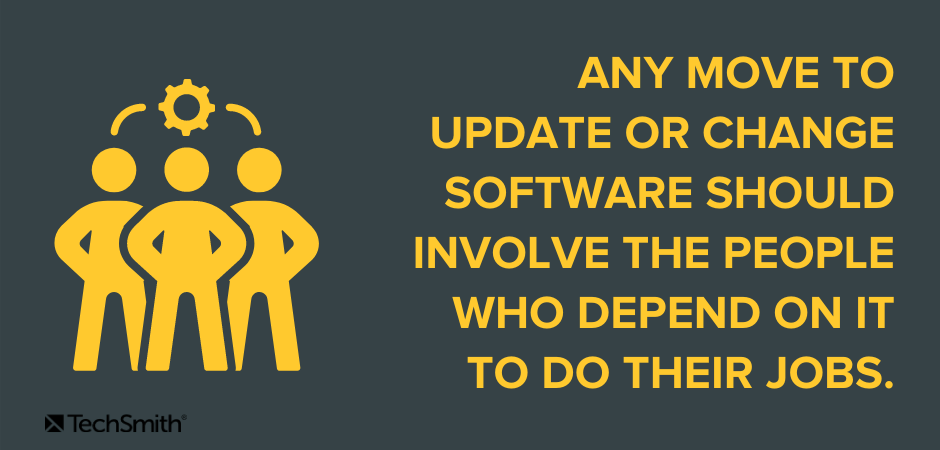
But, have you talked with the people who will be most affected by this change? Have you asked their needs and hopes for any new software? Have you discussed any potential pitfalls or concerns they may have about the change?
Any move to update or change software solutions should heavily involve the people who depend on it to do their jobs. You can do all the research in the world and you still won’t be as knowledgeable on the day-to-day requirements as those actually doing the work.
That may be easier in smaller orgs where you can simply talk to everyone one-on-one. Larger companies might need to get creative.
Here are a few ways to talk to users without actually having to talk to EVERY user:
- Focus groups
- Surveys
- Live Q&A sessions
- Webinars
- Slack/Teams channels
Regardless of how you do it, understanding what your users need will help get their buy-in when you let them know what’s changing. While you may not be able to satisfy all their requirements or concerns (let’s face it, there’s no such thing as the perfect software), they’ll feel listened to and you’ll show you care about their work.
And, there’s a potential bonus! By working with the various departments and colleagues who will use the new software, you may identify potential champions who can help advocate for and evangelize the new tool.
Whether they act as liaisons between their teams and yours or simply become sort of experts on the ground, it’s often very helpful to have someone in your corner at the user level.
Quickly and Easily Create Software Training Videos and Documentation
Camtasia and Snagit help you easily create everything from simple training guides to complete software training video courses — no pro skills required!
Communicate effectively for a successful software rollout
Have you sensed a theme in this post? Communication is the best tool in your toolbox for ensuring a successful software rollout.
But communication can’t be all about long emails from you and your team about what comes next.
Email will surely be an important way to communicate with your users, but it shouldn’t be the only way.
Throughout the pre-launch, launch, and post-launch phases of your rollout, use different means of communication to be sure that all your users have access to the information they need.
How to communicate with your users
Just like the examples above about getting buy-in, here are a few good ways to communicate important information:
Email is a great way to do quick updates and announcements. For most of us, our email application (such as MS Outlook) is also how we schedule meetings and other events. Definitely use that to your advantage.
Email is also incredibly impersonal and can feel overwhelming. Use it sparingly. Avoid long emails that require users to take in and remember a lot of information.
In-person/live remote meetings and events
Whether it’s a Q&A session, a webinar presentation on new features, or a roundtable discussion, live events offer a more personal and engaging experience for many users.
Pro tip: Record your live sessions and share them for anyone who couldn’t attend and so users can go back and watch for review if needed.

Video
Quick informational videos bridge the gap between email and live presentations. You can be more deliberate with what you want to present and you have more control over the pace and content.
Video is engaging and our research shows that more and more people seek out informational videos on their own.
Like with email, avoid long and overwhelming videos. If you have a number of topics to cover, consider creating a series of videos covering specific topics. That way, people can go back and review the ones they need to without having to remember where you talked about a particular feature in your 30-minute video.
Tips for effective communication about your software rollout
Any and all communications with your organization should center your users. Answer their questions, provide them with the information they need to be successful, and allay their fears and concerns.
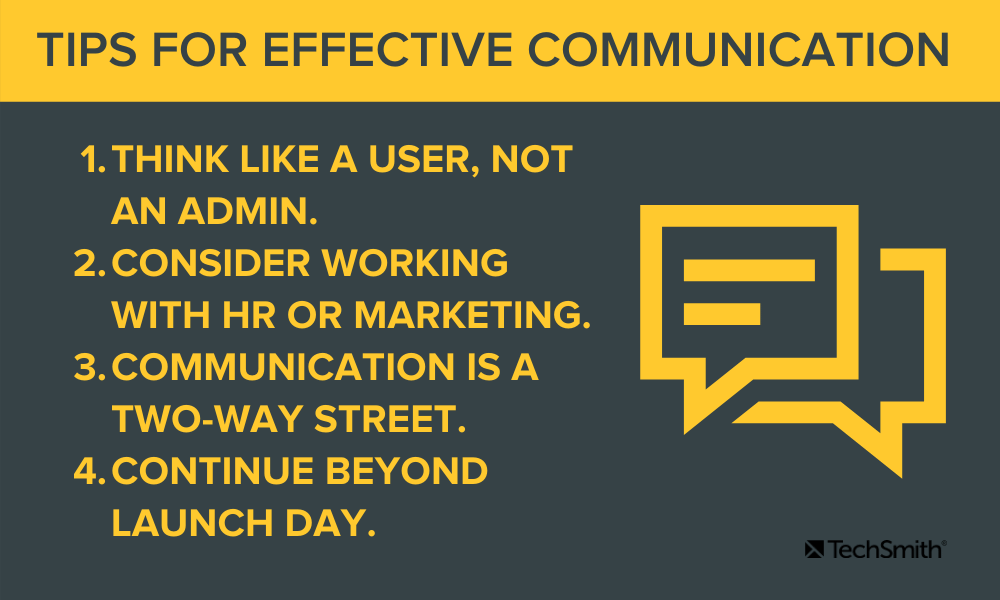
Here are a few things to keep in mind:
1. Think like a user, not an administrator
Avoid tech jargon or overly technical words and acronyms. If you absolutely must use a technical term, make sure you define it in a way that anyone could understand. As noted above, remember that not everyone is a technology expert. Make sure all communications are easy to comprehend.
2. Consider partnering with HR or marketing
If you really want to knock your communications out of the park, consider partnering with the communication experts in your organization. Your HR and marketing colleagues are well-versed in both helping people understand complex concepts and addressing fears and concerns.
3. Remember that real communication is a two-way street
Communication isn’t just what you blast out to your audiences. Real communication includes listening to and addressing feedback. Make sure your users have a way to ask questions, raise concerns, and ask for help.
4. Continue outreach beyond launch day
Your software rollout doesn’t end after deployment and neither should your communications. Keep the lines of communication open after rollout and don’t forget to gather feedback on how everything went.
Make training your #1 priority
But wait, I thought communication was key to a successful software rollout! What gives?
Well, what is training, but the communication of concepts and knowledge to those who need it?
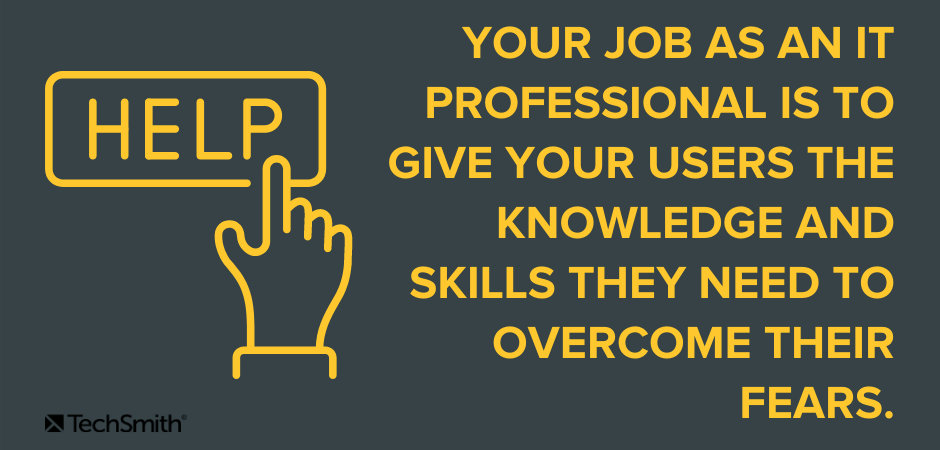
The reason people fear change at work is because they worry they won’t be able to function in the new environment. Your job as an IT professional is to give them the knowledge and skills they need to overcome their fears.
Just like your communications throughout the rollout process, your training should take various forms depending on the need. It’s a good idea to offer flexible options like visuals and video to roll out software platforms company-wide. That way, users can always go back and rewatch the information or it can be reused as a part of new employee onboarding.
There is nothing more daunting to most users (who are already nervous about new software) than facing a giant text document or emails full of paragraph after paragraph of technical information.
Don’t tell your users how to use the new software, show them!
Common effective training methods include:
- In-person or live remote training sessions.
- Long-form training videos.
- A library of short training videos addressing specific topics or features.
- Highly visual user documentation and help documents.
Remember, you don’t need to be a video or graphics professional to create professional-quality training videos and documents. TechSmith Camtasia and TechSmith Snagit offer powerful, but easy-to-use features that let anyone quickly and easily share knowledge and skills.
And, Camtasia and Snagit work great together, making your training videos and documents even more effective.
No matter what training methods you use, remember to center your users and their needs when creating your content.
Four mistakes to avoid for your software rollout
Even the most well-planned and executed software rollout can fail, but avoiding these four common mistakes can help you avoid catastrophe.
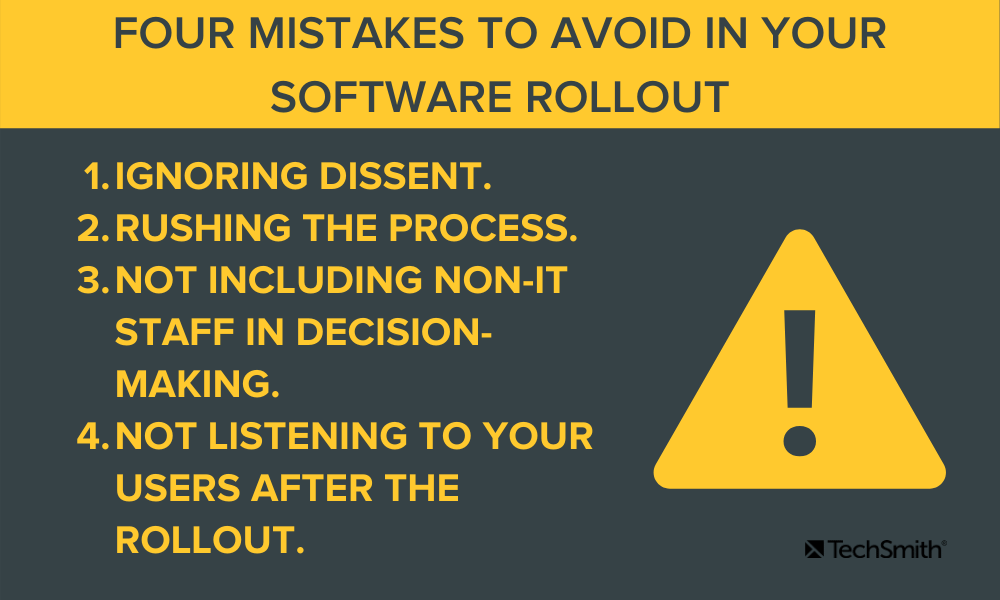
1. Ignoring dissent
Ever heard the phrase, “you can’t please everyone?” Even with the best communication, not everyone in your organization will be happy with the changes. There will always be someone who disagrees. And, while it’s easy to dismiss naysayers as, well, naysayers, ignoring them can lead to bigger problems down the road.
At best, they may feel you don’t take their concerns seriously, at worst, you risk missing out on important information that could help you make better decisions in the rollout process.
Listen to everyone and use the information as best you can.
2. Rushing the process
Give everyone (including your IT team) the time they need to get things in order before any software rollout. Give your users plenty of notice as to the upcoming changes so they have time to address their work, and you have time to address any concerns that may arise.
3. Not including non-IT staff in the decision-making process
In a user-centered approach to software rollout, you want to be sure to include the actual users in any decisions that affect their work. That doesn’t mean you have to talk to every single employee, but make sure there is ample opportunity for users to offer suggestions, feedback, and ideas on how to make it work.
4. Not listening to your users after the rollout
Gather feedback and listen to what worked and what didn’t. Use this information to help address issues with the current rollout and to inform better processes for the next one.
Center your users for software rollout success!
Centering your users in any software rollout helps ensure that everyone gets what they need when they need it.
Whether you’re rolling out new or updated software to 3, 30, or 3,000 people, having a strong plan that centers your users, has buy-in from all levels of your organization, and continues beyond launch day will help ensure success.
Quickly and Easily Create Software Training Videos and Documentation
Camtasia and Snagit help you easily create everything from simple training guides to complete software training video courses — no pro skills required!
Frequently asked questions
Each rollout is different, but whatever the plan, make sure you center your users and their needs and concerns in any plan you create. Be sure to have systems in place to answer the questions, and make sure training is your #1 priority.
You don’t have to be a video professional to create professional-quality software training videos. TechSmith Camtasia makes it easy to create effective and engaging software training videos for your software rollout.
Make sure any user documentation you create includes visuals! TechSmith Snagit makes it easy to create all kinds of user documentation, including how-to guides, step-by-step process docs, and more!


